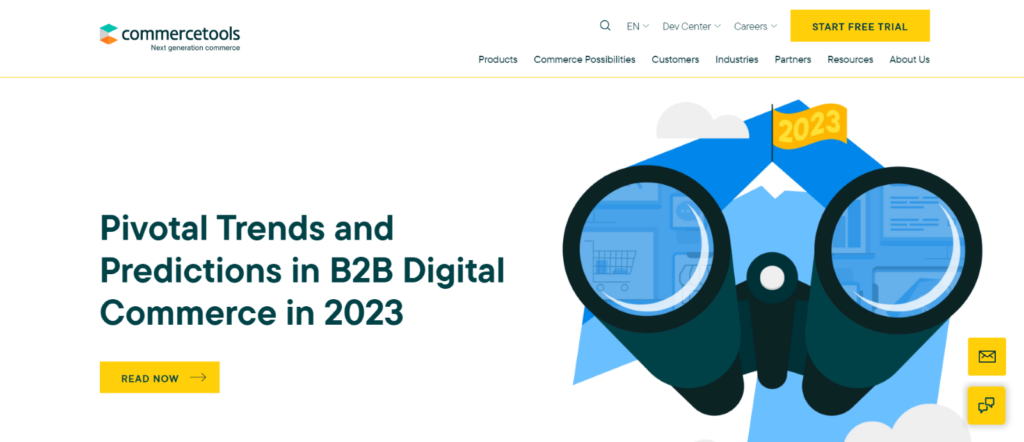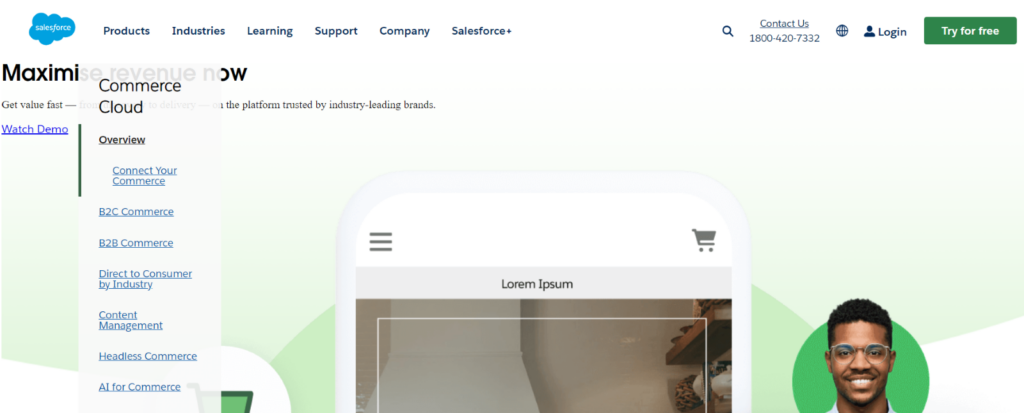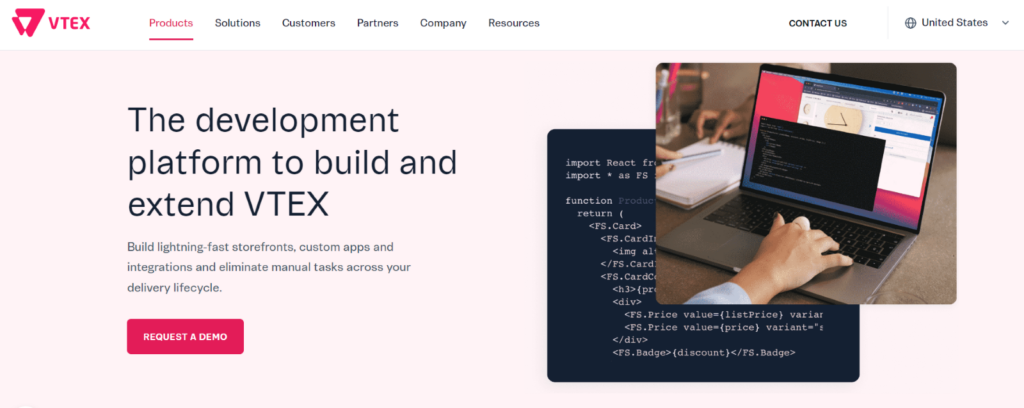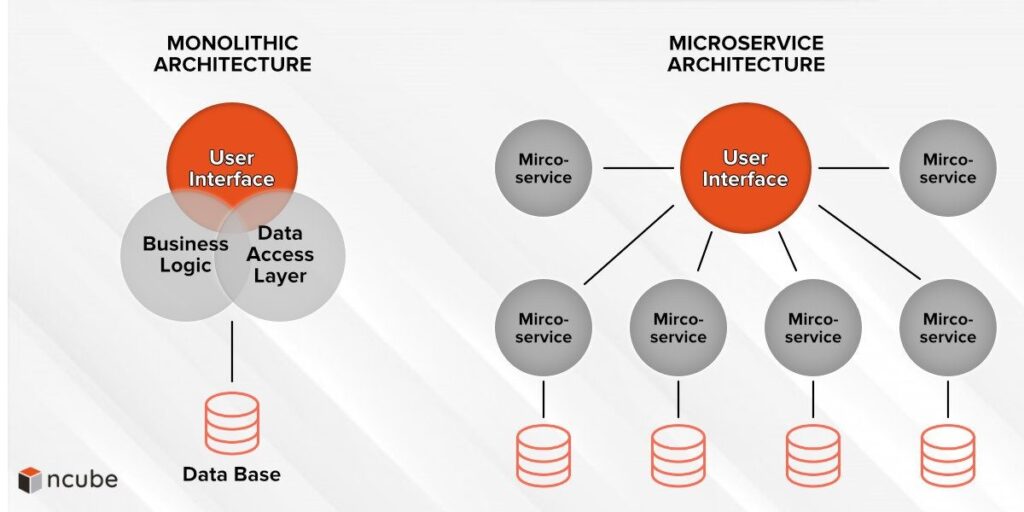
Key Takeaways
- Composable commerce is a type of eCommerce that allows businesses to create customized shopping experiences for their customers by integrating multiple products, services, and technologies into one ‘composite’ store.
- There are many benefits to using composable commerce including increased cost-effectiveness, improved customer satisfaction levels, and greater agility.
- However, there are also some drawbacks such as complexity and limited scalability.
- There are several composable commerce platforms such as Experro, Commercetools , Salesforce Commerce Cloud, and VTEX IO.
By 2023, companies that have adopted a composable commerce strategy will be able to release new features at a rate of 80% faster than their rivals. Isn’t it shocking?
In today’s era, digital commerce footprints no longer follow the one-size-fits-all concept from a single provider.
Today’s eCommerce environment is quite challenging.
Companies can no longer rely on outdated legacy platforms that can’t keep up with the saturation of the market, the demand for new digital experiences among consumers, and the growth of touchpoints.
This demand for innovation in the online retail sector gave rise to the composable commerce movement.
In this guide we will explore the concept of composable commerce, its benefits, features, drawbacks, as well as provide examples of some successful companies.
What is composable commerce?
Composable commerce is a way of organizing, managing, and delivering e-commerce products.
It helps businesses to create customized shopping experiences for their customers through the integration of multiple products, services, and technologies into one ‘composite’ store.
It also allows businesses to integrate with third party and leverage external services and technologies that are not included in their core e-commerce platform.
This integration can be achieved through APIs and other integration mechanisms, which allow businesses to easily connect with and use third-party services for functions like payment processing, shipping, customer service, and more.
By adopting a composable commerce approach, businesses can build and manage e-commerce platforms that are more flexible, scalable, and adaptable to changing market conditions.
Benefits of composable commerce
1. Flexible pricing:
Businesses can use composable commerce to offer customers, flexible pricing models, allowing them to pay only for the components they need, helping them to stay competitive in the marketplace.
This helps to generate more revenue and provide customers with greater value at the same time.
2. Valuable Data insights:
Composable commerce provides businesses with valuable data insights. It has ability to track customer behavior to anticipate their needs in real-time.
It allows them to make more informed decisions about how they manage their business and serve their customers.
This helps businesses remain competitive in the marketplace by providing customers with the most relevant and up-to-date products or services available.
3. Increased cost-effectiveness:
Using composable commerce, businesses can reduce their operational costs by streamlining processes of eliminating the need for manual labor to create or update products and services.
These cost savings can be reinvested into other areas of the business, such as marketing or customer service, resulting in higher ROI.
4. Improved customer satisfaction:
With composable commerce, customers have the opportunity to customize their shopping experience according to their preferences and needs.
This allows them to create a personalized buying journey that is tailored specifically to their individual wants or needs.
Resulting in improved satisfaction levels as they are able to find what they need more quickly and easily.
5. Greater agility:
By utilizing composable commerce, businesses are able to increase their agility and easily create new products, services, and experiences with the same components.
This can help them keep up with market trends and customer preferences more efficiently than ever before.
6. Multi-channel support:
Composable commerce also allows businesses to provide customers with a unified experience across multiple channels, such as web and mobile applications.
This allows them to create an immersive shopping environment that caters to their needs and preferences, regardless of what device they are using.
This also helps businesses stay connected with their customers even when they’re not in the store.
7. Personalization:
Finally, composable commerce enables businesses to customize their products or services to individual customers’ needs.
It also helps them to build loyalty by creating a more personalized shopping experience that is tailored specifically to each customer’s preferences.
This helps increase satisfaction levels as they are able to find what they need.
8. Operational security:
Composable commerce can enhance operational security by allowing businesses to isolate and secure individual components of their e-commerce platform.
This reduces the risk of a security breach affecting the entire system and allows businesses to manage security risks more effectively.
Drawbacks of composable commerce
1. Complexity:
It does take some technical expertise to set up and run a shop using composable commerce.
This can be difficult for businesses who are unfamiliar with programming tools or eCommerce platforms.
2. Limited scalability:
Although composable commerce enables businesses to quickly create new products, services, and experiences, its scalability can be limited by the number of components available in the platform.
3. Security concerns:
As composable commerce involves the integration of multiple technologies into one platform.
It is important that businesses ensure that there are sufficient security measures in place to protect their customer’s sensitive data from being compromised.
If this will happen it will be difficult to build trust according to the customer’s point of view.
Features of composable commerce
1. Open Modular architecture:
Composable commerce architecture allows businesses to easily add, remove, and customize components.
In order to create unique digital experiences tailored to their customers’ needs- all while maintaining a level of control over how they manage the order fulfilment process.
2. Open Ecosystem:
Composable commerce has an open ecosystem. Therefore, you are not forced to use a specific vendor.
You are free to use a completely different service to build your product pages if you utilize one piece of software to manage subscription and recurring payments.
This is extremely important if the platform you’re utilizing changes or becomes outdated.
3. Flexibility:
Using composable commerce, businesses are able to quickly modify existing products or create new ones without having to build the entire process from scratch.
This allows them to easily adapt to different customer needs and market trends, helping them stay ahead of their competition while maximizing profits.
4. Business-Centric:
Why does it matter that modular, open, and flexible composable commerce exists?
Because doing so enables you to rapidly and affordably modify your store to suit the requirements of your company.
You don’t have to switch to a completely different platform when you need to give your eCommerce site more functionality.
Additionally, you can cease paying for any components of your application that you aren’t utilizing.
5. Automation:
Composable commerce enables businesses to automate many of their processes, such as inventory management and order fulfilment to help them reduce operational costs while improving the customer engagement.
This automation also helps businesses to quickly respond to changing market conditions or customer demand more efficiently than ever before.
Platforms of composable commerce
1. Experro:

Experro is an all-in-one platform designed to meet the eCommerce needs of enterprises.
It offers a range of features to help businesses optimize their online store, personalize the customer experience, and automate marketing efforts.
Some of the key features of Experro include a Headless CMS, Customer Data Platform, Marketing Automation flow, AI search, and Merchandising.
2. Commercetools:

The commercetools platform is based on the MACH design tenets of microservice-based, API-first, cloud-native, and headless.
This platform assists you in putting together the microservices your company needs and wants.
It allows you to integrate third-party solutions to create custom workflows.
It also provides features such as product catalog management, shopping cart functionality, order tracking, shipping notifications, and more.
Additionally, it offers a range of pricing options that include both fixed plans and customized plans for each microservice.
3. Salesforce Commerce Cloud:

Salesforce Commerce Cloud is a platform offering composable commerce solutions to help businesses build and manage their eCommerce stores.
It provides features such as catalog management, order processing, customer insights analytics, payments processing, fraud protection services, and more.
The platform also multiple pricing plans for businesses of all sizes.
4. VTEX IO:

VTEX IO offers two products: a low-code development tool, and VTEX Commerce Cloud. Customers can build their own eCommerce solution by mixing the two.
VTEX is composable commerce that include features like one-click checkout, secure payments, a CMS, and omnichannel services.
VTEX provides a revenue-sharing on-demand pricing mechanism.
Examples of composable commerce
1. Stack:
Stack is a typical example of composable eCommerce which includes the features like order management, inventory, salsify product information management (PIM).
2. TaxJar:
TaxJar offers sales tax automation, compliance services, shipping, and fulfilment.
3. Stripe:
Stripe provides secure payment gateway solutions, as well as API access to create custom checkout experiences. By leveraging the modularity of composable eCommerce, businesses can quickly customize their checkout process to match their customers’ needs.
4. Calendly:
It helps you save time scheduling appointments which offers integration with Google Calendar and other calendar systems.
This integrates with your e-commerce platform that allows customers to effortlessly schedule appointments or book services without leaving the page.
By utilizing composable services, you can offer customers the convenience of a one-stop shop for all their commerce needs.
These are some examples of composable commerce solutions that businesses are leveraging to improve customer experience and drive revenue.
This allows them to respond to changing market conditions or customer demands more efficiently than ever before.
Best Practices for composable commerce
1. Understand your business needs:
Before implementing composable commerce, it’s important to understand your business needs and goals.
Define your business requirements, target market, along with services, and products you offer.
This information will help you identify the capabilities you need in a composable commerce solution.
2. Research vendors:
When looking for a composable commerce solution, research and evaluate vendors based on your business needs.
Consider factors such as the vendor’s experience, reputation, scalability, and pricing.
Make sure the vendors offer the best products for your particular business needs is key to creating a successful eCommerce platform.
3. Integrate with other systems:
Composable commerce requires integration with other systems, such as inventory management, order fulfillment, and customer relationship management (CRM) systems.
Determine which systems you need to integrate with and make sure your composable commerce solution can easily integrate with them.
4. Establish a well-defined strategy:
Define a strategy for implementing composable commerce that aligns with your business goals.
Create a plan for the deployment, migration, and training of employees.
Ensure that you have a clear understanding of the architecture, functionality, and capabilities of the composable commerce solution.
5. Monitor usage & performance:
Continuously monitor the usage and performance of your composable commerce solution.
Analyze data on customer behavior, sales, and operational efficiency.
Use this information to make data-driven decisions and optimize the performance of your composable commerce system.
What is composable commerce architecture?
Composable commerce architecture is a set of practices to create eCommerce applications that are composed of individual components from different vendors.

The principle behind this composable commerce architecture-
- Businesses can take advantage of existing services and quickly integrate them into their own architectures without having to build everything from scratch.
- This allows businesses to be flexible, responsive, and agile while also giving them more control over their eCommerce applications.
- Composable commerce architecture also enables businesses to quickly scale their operations as needed, and gives them access to a wide variety of services or solutions.
- This increases the potential for businesses to offer customers a better experience, faster delivery times, increased sales and customer retention.
Overall, composable commerce architecture offers many advantages for businesses looking to stay competitive in the eCommerce space.
What is the role of AI in machine learning in composable commerce architecture?
AI and machine learning can help businesses extract valuable insights from the data generated by their composable services. By leveraging AI and machine learning, businesses can glean information about their customers’ behaviour to better understand their preferences and provide personalized experiences.
This could be done through predictive analytics that identify patterns in customer behaviour, or natural language processing that can help businesses better understand how their customers interact with the eCommerce platform.
Additionally, AI and machine learning can be used to provide real-time feedback on performance metrics, such as conversion rates or average order value, allowing businesses to quickly identify any issues and make adjustments accordingly.
Overall, the role of AI and machine learning in composable commerce architecture is to provide businesses with valuable insights that can help them better understand their customers and develop more successful eCommerce applications.
By leveraging the power of AI and machine learning, businesses can create unique customer experiences that drive revenue growth.
Composable Commerce vs Headless Commerce

Headless commerce is an eCommerce architecture that separates the front-end user experience from the back-end systems by decoupling the two.
This allows businesses to create new customer experiences without needing to completely rebuild their existing systems, which can be costly and time consuming.
Composable commerce, on the other hand, is an architecture that enables businesses to build custom eCommerce applications efficiently by combining services from different vendors.
It allows businesses to be agile and responsive to changes in the market and customer demands, while also providing them with more control over their eCommerce platforms.
Overall, both architectures can help businesses improve customer experience and drive revenue, but composable commerce provides the additional benefits of scalability, flexibility, and access to a wider variety of services.
Additionally, composable commerce can help businesses create more personalized experiences for customers that are tailored to their specific needs.
Composable Commerce vs Traditional Commerce
In traditional commerce, businesses have limited options for customizing their eCommerce applications.
This often means they’re stuck using outdated technology that can be costly to maintain and upgrade.
Additionally, the lack of flexibility in traditional commerce architectures makes it difficult for businesses to quickly adapt to changes in the market or customer demands.
On the other hand, composable commerce allows businesses to quickly build applications that are tailored to their customer-specific needs.
It also enables businesses to leverage existing services and quickly integrate them into their architectures without having to completely rebuild everything from scratch.
This gives businesses more adaptability, scalability, and accessibility to a wider range of services, all of which can help them increase revenue and provide a better customer experience.
Overall, composable commerce offers businesses many advantages over traditional commerce architectures.
Wrapping up
More than ever before, consumers are interacting with companies by using their products in new ways. Social media platforms have evolved into customer support, marketing, and sales.
We make purchases through pop-up shops, online marketplaces, mobile devices, and occasionally even smart speakers or gaming consoles. Trade is multichannel. Right?
The good news is that composable commerce is here to help businesses stay ahead of the curve.
Businesses now have more control over their applications because of this new eCommerce architecture, which also provides scalability, flexibility, access to services from various vendors, and the capacity to swiftly design customized user experiences.
All of these features combine to provide businesses with a powerful platform that can help them remain competitive and drive revenue.
So, if you’re looking to create a custom eCommerce solution that’s tailored to your specific needs, composable commerce just might be the answer you’ve been searching for.
